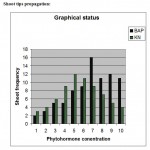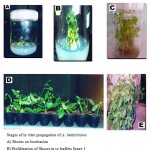How to Cite | Publication History | PlumX Article Matrix
Technique For Rapid Micropropagation Of Alternanthera Bettzichiana (Regel) Nicols
J.C. Hundiwale1*, M.V. Kulkarni1, G.P. Vadnere2, R.G. Mali2 and S.R. Patil3
1Department of Life Sciences, North Maharashtra University, Jalgaon - 425 001 (India). 2Smt. Sharadchandrika Suresh Patil College of Pharmacy, Chopda - 425 107, Dist. Jalgaon (India). 3Bhumiputra Biotechnology Institute, Chopda - 425 107 Dist. Jalgaon (India).
ABSTRACT: A simple and efficient micropropropagation protocol was developed for Alternanthera bettzichiana using shoot tip as explants. The explants were culture in MS basal medium fortified with phytohormones and different concentration of cytokinins (BAP and KN). Maximum shoot proliferation from single explant was obtained on MS Medium incorporated with KN (5 mg/l) and MS medium with BAP Concentration ( 7 mg/l) showed highest and significant frequency of root proliferation. KN showed formation of small clusters only. Successful hardening-off is achieved using conditions of relatively low humidity. In Vitro regenerated plantlets were healthy and attained heights of 5-6 cm in 5 weeks which were transferred to field conditions after acclimatization with the success rate of 80 % without any seasonal constraints.
KEYWORDS: Alternanthera bettzichiana; Shoot tips; Shoot proliferation; Phytohormones
Download this article as:| Copy the following to cite this article: Hundiwale J. C, Kulkarni M. V, Vadnere G. P, Mali R. G, Patil S. R. Technique For Rapid Micropropagation Of Alternanthera Bettzichiana (Regel) Nicols. Biosci Biotechnol Res Asia 2008;5(1) |
| Copy the following to cite this URL: Hundiwale J. C, Kulkarni M. V, Vadnere G. P, Mali R. G, Patil S. R. Technique For Rapid Micropropagation Of Alternanthera Bettzichiana (Regel) Nicols. Biosci Biotechnol Res Asia 2008;5(1). Available from: https://www.biotech-asia.org/?p=6927 |
Introduction
Tissue culture techniques being increasingly exploited for clonal multiplication and in vitro conservation of valuable indigenous germplasm threatened with extinction. Greater demand for these plants especially for the purpose of food and medicine is one of the causes of their rapid depletion from primary habitats. Plant cells and tissue cultures hold great promise for controlled production of a myriad of useful secondary metabolites1. Micropropagation offers a great potential for large scale multiplication of such useful species and subsequent exploitation 2. Many improved plant varieties has been regenerated using tissue and cell cultures techniques 3, 4. The Amaranthaceae are mostly herbs but rarely also shrubs or small trees comprising 65 genera and 900 species further characterized by the presence of betalains and p-plastids. The genus Alternantera, a medicinally important member of family Amaranthaceae is widely used for the presence of volatile constituents, essential amino acids, flavone glycoside and steroids Alternanthera bettzichiana, a horticulture species of many forms, is often found as an escape, reported for its potential claims in certain viral diseases5as an immunnomodulator6, protective agent against cancer7, and in treatment of diarrhoea8. Although adventitious shoot regeneration is a basic prerequisite for the application of generic engineering to crop improvement, the production of plants from apical meristems and axillary buds has proven to be the most generally applicable and reliable method of in vitro micropropagation. This paper describes a rapid and efficient in vitro micropropagation system from shoot explants of Alternanthera bettzichiana.
Experimental
Materials and Method
Establishment of aseptic explant: Alternanthera bettzichiana growing wild in the field was collected and authentificated from Botanical Survey of India, Pune and planted at the herbal garden of our departmental laboratory. Alternanthera bettzichiana, much branched, diffuse herbs, stem ribbed, green; young branches white pubescent with spike like minute flower9. Apical meristem and shot tips of the plant were used as explants and were first washed with detergent and rinsed under running tap water for 30 minutes. They were then dipped into 70% alcohol for one minute before surface sterilizing, using mercuric chloride (HgCl2) 0.08% (w/v) for 5 minutes. After rinsing three times with sterile distilled water, the explants were again sterilized with Clorox 0.15% (w/v) for 15 minutes. They were then again rinsed three times with sterile distilled water. The explants were dried using sterile filter paper before inoculating into basic MS culture medium 10 containing 3% (w/v) sucrose. The pH of the medium was adjusted to 5.7-5.8 followed by addition of 7.5 g l-1 bacto agar before autoclaving at 1210C and 1.06 kg/cm2 for 13 minutes using autoclave. All the cultures were incubated at 25 ± 20C under 24-h photoperiod provided by white fluorescent light with a light intensity of 32.5 mE m-2 s-1. The aseptic shoots that were obtained after two weeks of cultures were used as the source of explants for the subsequent experiments.
Organogenesis / Induction of multiple shoots formation: The apical meristem and shoot tips were cultured on MS medium supplemented with various concentrations of BAP and KN using a factorial experimental design. The pH of the culture media was adjusted to 5.7-5.8 with 0.1M NaOH or 0.1 M HCl prior to autoclaving at 1210C and 1.06 Kg/Cm2 for 13 minutes using autoclave. Ten explants were used for each medium treatment and the experiment was repeated three times. The cultures were incubated at 25 ± 20C under continuous illumination with cool white fluorescent tubes at an intensity of 32.5mE M-2 s-1. Responses of the culture were observed and recorded over a period of five weeks. The shoot length and number of shoots formed were recorded. Explant that produced more than two shoots was considered as multiple shoots. The in vitro regenerated plantlets were transferred to root trainer cups containing a mixture of sterile soil and sand (3:1) for hardening. They were irrigated every 24 hrs.with a solution containing MS salts at half strength. High humidity levels were maintained by covering the pots with polyethylene bags. Progressive puncturing of polyethylene bags decreased the humidity levels and simultaneously they were exposed to sunlight. After four weeks the hardened plants were transferred to nursery.
Result and Discussion
Within 5 weeks, an average of 3 to 5 shoots were formed from each apical meristem of Alternanthera bettzichiana when they were cultured on MS supplemented with 1.0 to 10 mg/l of BAP and with KN respectively. The addition of KN, as low as 1 mg/l, into MS medium containing BAP, however, did not show significant influence on multiple shoots formation from the apical meristem explants (Table 1). This observation suggested that the induction of multiple shoots formation of alternanthera bettzichiana depended only on the presence of BAP in the culture medium. The apical meristem and shoot tips culture on basic MS medium with BAP produced significant shoots with complete root system (fig.1). All the multiple shoots formed in MS media supplemented with only BAP of 7.0 and 9.0 mg/1 showed formation root system (fig. 1), while with KN showed formation of small clusters, and accompanied with swelling and callus growth without root system. It is observed that high concentration of cytokinin generally inhibited root formation of plants 11. More multiple shoots formed when the explants were cultured in MS Medium supplemented with only BAP at an average concentration of 7.0 and 9.0 mg/l. However the number of shoots formed over and above this range of BAP concentration was significantly different. Small shorter shoots were formed as the concentration of with KN present in the culture medium. Result indicated that culture medium MS with 7 mg/l of BAP was sufficient to produce multiple shoots culture of alternanthera bettzichiana. Results are very indicative for the varying proportion of growth multiplication in average concentration of only BAP and KN as shown in table 1 and 2. Su et al 12 reported that MS medium added with low concentrations of BAP produced normal shoots and roots for Typhonium flagelliforme. The Same phenomena was observed for Alternanthera bettzichiana and all its in vitro multiple shoots were normal with complete root system when average concentration of BAP was added into the culture medium.
An in vitro propagation of Alternanthera bettzichiana could be achieved by culturing the aseptic apical meristem and shoot tips explants on MS medium supplemented with 7.0mg/l of BAP.
Table 1: Number of shoots formed Alternathera bettizichiana when cultured in MS medium supplemented with only BAP (1.0-10.00 mg/L) within five weeks.
| Sr. No. | MS + BAP (mg/l) | Number of shoots
Mean ± SEM |
| 01 | 00 | 1.0 ± 0.13 |
| 02 | 01 | 2.0 ± 0.21 |
| 03 | 02 | 3.0 ± 0.14 |
| 04 | 03 | 5.0 ± 0.21 |
| 05 | 04 | 5.0 ± 0.21 |
| 06 | 05 | 8.0 ± 0.29 |
| 07 | 06 | 9.0 ± 0.21 |
| 08 | 07 | 16.0 ± 0.74 |
| 09 | 08 | 11.0 ± 0.29 |
| 10 | 09 | 12.0 ± 0.39 |
| 11 | 10 | 11.0 ± 0.25 |
Table 2: Number of shoots formed Alternathera bettizichiana when cultured in MS medium supplemented with only KN (1.0-10.00 mg/L) within five weeks
| Sr. No | MS + KN (mg/l) | Number of Shoots
Mean ± SEM |
| 01 | 00 | 1.0 ± .013 |
| 02 | 01 | 3.0 ± 0.14 |
| 03 | 02 | 4.0 ± 0.25 |
| 04 | 03 | 6.0 ± 0.47 |
| 05 | 04 | 9.0 ± 0.39 |
| 06 | 05 | 12.0 ± 0.51 |
| 07 | 06 | 11.0 ± 0.39 |
| 08 | 07 | 9.0 ± 0.33 |
| 09 | 08 | 7.0 ± 0.29 |
| 10 | 09 | 5.0 ± 0.39 |
| 11 | 10 | 4.0 ± 0.25 |
 |
Figure 1: Shoot tips propagation.
|
 |
Figure 2: of Stages of in vitro propagation of A. bettzichiana.
|
Acknowledgement
We thanks to University staff for their kind co-operation during the work at department and out of the department for the research facilities. Author was also thankful to the entire team of Smt. Sharadchandrika Suresh Patil College of Pharmacy, Chopda-425107, Dist. Jalgaon (MS).
References
- Wei Zhang, Chris Curtin and Simon Conn, J. Biomed Biotechnol., 05: 264-271, 2004.
- Boro, P.S., Sharma Deka AC and Kalita MC, Phytol.Res. 11:103-106, 1998.
- George, E.F., Sherrington, P.D., Plant propagation tissue culture, Basingstoke, Exegetics Ltd, Westbury, 1984.
- Lindsey, K., Jones, M.C.K., Plant Biotechnology in Agriculture, Open University Press, Milton Keynes, 57-58, 1989.
- Zhou C, Phytochemistry, 27: 36-33, 1988.
- Guerra R.N.M., Pereira H.A.W., Silveira L.M.S., and Olea R.S.G., Braz J Med Biol Res, 9: 65-68, 2003.
- Shridhar and Lakshminarayana, , J. Agric Food Chem, 44:41-61, 1993.
- Burkill, H.M, The useful plants of west tropical Africa,.1: 247-249, 1985.
- Geeta, C. and Bhattacharyya, U.C., The genus Alternanthera (Amaranthaceae) in India, Bull. Bot. Surv. India, 36:267-277, 1994.
- Murashinge, T. and F. Skoog, , Plantarum, 15:473-497, 1962.
- George, E., Shcraudolf, H. and J. Reinert, Nature. 184:465-466, 1959.
- T.S., L.K. Chan, N. Pargini and C.K.H. Teo, In Vitro Cell. Dev. Biol. Plant, 36: 402-406, 2000.

This work is licensed under a Creative Commons Attribution 4.0 International License.





